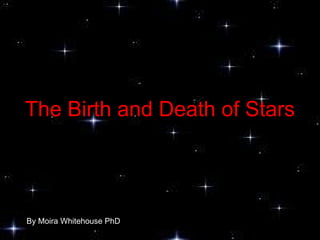Birth & death of stars (teach)
•Télécharger en tant que PPT, PDF•
31 j'aime•17,673 vues
A short description, at the elementary school level, describing stars and telling how they are created and how they end.
Signaler
Partager
Signaler
Partager

Recommandé
Recommandé
Contenu connexe
Tendances
Tendances (20)
En vedette
En vedette (20)
Similaire à Birth & death of stars (teach)
Similaire à Birth & death of stars (teach) (20)
Plus de Moira Whitehouse
Plus de Moira Whitehouse (20)
Plants and animals depend on each other. (teach 2nd/3rd grade)

Plants and animals depend on each other. (teach 2nd/3rd grade)
Weathering, Erosion and Deposition.(3rd/4th grade teach)

Weathering, Erosion and Deposition.(3rd/4th grade teach)
Soil science for teachers (massive-the real dirt on soil)

Soil science for teachers (massive-the real dirt on soil)
Dernier
Mehran University Newsletter is a Quarterly Publication from Public Relations OfficeMehran University Newsletter Vol-X, Issue-I, 2024

Mehran University Newsletter Vol-X, Issue-I, 2024Mehran University of Engineering & Technology, Jamshoro
Dernier (20)
Beyond_Borders_Understanding_Anime_and_Manga_Fandom_A_Comprehensive_Audience_...

Beyond_Borders_Understanding_Anime_and_Manga_Fandom_A_Comprehensive_Audience_...
Unit 3 Emotional Intelligence and Spiritual Intelligence.pdf

Unit 3 Emotional Intelligence and Spiritual Intelligence.pdf
General Principles of Intellectual Property: Concepts of Intellectual Proper...

General Principles of Intellectual Property: Concepts of Intellectual Proper...
Interdisciplinary_Insights_Data_Collection_Methods.pptx

Interdisciplinary_Insights_Data_Collection_Methods.pptx
Python Notes for mca i year students osmania university.docx

Python Notes for mca i year students osmania university.docx
Plant propagation: Sexual and Asexual propapagation.pptx

Plant propagation: Sexual and Asexual propapagation.pptx
Sensory_Experience_and_Emotional_Resonance_in_Gabriel_Okaras_The_Piano_and_Th...

Sensory_Experience_and_Emotional_Resonance_in_Gabriel_Okaras_The_Piano_and_Th...
Exploring_the_Narrative_Style_of_Amitav_Ghoshs_Gun_Island.pptx

Exploring_the_Narrative_Style_of_Amitav_Ghoshs_Gun_Island.pptx
Birth & death of stars (teach)
- 1. The Birth and Death of Stars By Moira Whitehouse PhD
- 5. • Stars form groupings called galaxies. • There are about 80-100 billion galaxies in that part of the Universe we can observe. • There may be more in the Universe beyond what we are able to detect. • Each galaxy has billions or trillions of stars. • Many astronomers believe that stars in a galaxy orbit around a black hole.
- 6. Hubble Ultra Deep Field image with a huge number of galaxies.
- 7. 5 galaxies Hickson Compact Gp 52
- 8. interacting Galaxy Pair Arp 8
- 10. NASA /JPL-Caltech Artist’s image of the Milky Way
- 11. Infrared image of the Milky Way—Cosmic Background Explorer (COBE) satellite NASA
- 12. Spiral Galaxy M7
- 13. How Are Stars “Born”?
- 15. A nebula called NGC 6302. What resembles butterfly wings are actually boiling cauldrons of gases heated to more than 36,000 degrees F.
- 17. • Sometimes part of the cloud shrinks and forms a ball as gravity pulls the gas and dust particles closer and closer together. • The gas and dust inside the ball bump into one another causing the temperature to rise.
- 19. • The heated gases expand balancing the inward pull of gravity. gravity hot gases expanding
- 20. • The energy moves through the outer layers of the ball and into space as electromagnetic radiation. • The visible light causes the ball to glow ••••••• and
- 21. ……… a new star is born!
- 22. Embryonic stars in the Eagle Nebula
- 23. Stars bursting into life in Carina nebula
- 24. A firestorm of stars being born in Galaxy NGC 604
- 25. Intense bursts of stars that have formed over the last few tens of million years. • The Hodge Cluster 301 Many stars forming in the Tarantula Cluster in the Large Magellanic Cloud galaxy
- 26. What Happens During the “Life” of a Star
- 29. How does a Star “Die”?
- 35. • The star then sheds its outer layers of gas and dust and becomes planetary nebulae. • When a planetary nebular forms, there is only about 20% of the original star left.
- 36. Twin jet nebula Ant nebula Two planetary nebula
- 37. • The planetary nebula spends the rest of its life cooling and shrinking until it becomes a few thousand miles in diameter. • Finally it becomes a……
- 38. • white dwarf-- a very dense ball. • It continues to give off heat for billions of years until it finally becomes a black dwarf and ceases to shine--you can no longer see it.
- 39. Image from the Liverpool Telescope Here you can see a planetary nebula called M57 with its White Dwarf in the middle.
- 43. Red Supergiant Star V838 Monocerotis
- 44. Betelgeuse a red supergiant nearing its end.
- 45. Upper section of the picture is the bluish color of hot stars newly formed stars reflected by a cloud of cool gases and dust. The lower red section is Antares, a super red giant which is gradually shedding layers.
- 46. Antares – a Red Super Giant Anatares, a Red Super Giant in the Milky Way Galaxy in the process of dying.
- 49. Crab Nebula with remnants of a star’s supernova explosion.
- 50. • huge stars 1.5 to 3 times the mass of the Sun shrink and form a neutron star. After the supernova explosion: • giant stars 3 times the mass of the Sun shrink and form a black hole.
- 51. Neutron star
- 52. This deep Chandra X-ray Observatory image shows the supernova remnant Kes. The explosion of a massive star created the supernova remnant, along with a pulsar-- a rapidly spinning neutron star.
- 53. Eta-Carinae supernova with a neutron star
- 54. A NASA image illustration of a supermassive black hole ripping apart a star and consuming part of it.
- 55. This black hole has about 3.8 times the mass of our sun, and is orbited by a companion star, as shown in this illustration. Credit: NASA/CXC/A. Hobar
- 56. The debris from a supernova explosion is blown away and forms a glowing cloud called a supernova remnant.
- 57. Remnants of a supernova
- 58. Supernova Remnant from Palomar
- 59. Remnants of a supernova and pulsar in the middle of the remnants
